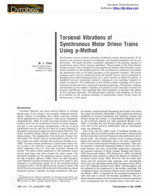Papers
“Torsional Vibrations of Synchronous Motor Driven Trains Using p-Method,” |
Abstract
Synchronous motors produce damaging oscillating torques during startup. If the system is not properly analyzed and designed, the torsional excitation can be very destructive. This paper pre:;ents a systematic approach to the dynamic analysis of synchronous motor driven rotating machinery. The p-version of the finite element method is used in the formulation of the equations of motion which provides a great deal of simplicity in the modeling process. The convergence is achieved by increasing the polynomial order of the basis functions of the geometric elements. The system damping matrix can be constructed from the element level or can be calculated by specifying the critical damping factors for a given number of modes of interest. A modified Newmark integration method is employed in the nonlinear transient response calculation. The nonlinearity of the flexible resilient couplings can be easily implemented into this direct numerical integration algorithm. The dynamic stiffness and damping of the resilient couplings are updated at each time step to ensure the dynamic equilibrium. Two examples have been employed to illustrate the validity of the proposed algorithm. The effectiveness, accuracy, and simplicity of the use of p-method on the torsional vibration of synchronous motor driven trains are demonstrated in this paper.

